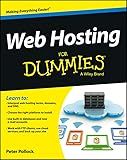Best Web Hosting Services for FuelPHP to Buy in December 2025

Web Hosting For Dummies



Modern Web Development: A Beginner's Guide to HTML, CSS, Hosting, and SEO



Web Development with Blazor: A practical guide to building interactive UIs with C# 12 and .NET 8



The Ultimate WHM Guide (Web Hosting with cPanel)



A Moron's Guide to Web Hosting: On Amazon, Service, Servers and More



How to create website for beginners plus free domain and hosting


Running FuelPHP on web hosting requires some technical knowledge and steps to be followed. Here is a brief tutorial on how to accomplish it:
- Choose a Web Hosting Provider: Look for a web hosting provider that supports the necessary requirements for running FuelPHP. Ensure that they meet the minimum requirements such as PHP version, database support (e.g., MySQL, PostgreSQL), and access to the server configuration.
- Download and Install FuelPHP: Visit fuelphp.com and download the latest stable version of FuelPHP. Extract the downloaded zip file on your local computer.
- Upload Files to Web Hosting: Connect to your web hosting account using FTP or a file manager provided by the hosting provider. Create a new directory for your FuelPHP application on the server. Upload all the extracted FuelPHP files and folders to this directory.
- Configure Database: In the FuelPHP root directory, locate the fuel/app/config/development/db.php file. Modify the necessary database connection details such as hostname, username, password, and database name. Save the file.
- Enable URL Rewriting: If your hosting provider supports Apache web server, create an .htaccess file in the FuelPHP root directory. Insert the following lines of code to enable URL rewriting:
RewriteEngine on RewriteBase /path/to/fuelphp/ RewriteCond %{REQUEST_FILENAME} !-f RewriteCond %{REQUEST_FILENAME} !-d RewriteRule ^(.*)$ index.php/$1 [L]
Replace /path/to/fuelphp/ with the relative path to your FuelPHP installation.
- Set File Permissions: Ensure that proper file permissions are set for FuelPHP directories. Typically, the fuel/app/logs/ and fuel/app/cache/ directories should be writable by the server. Set the directory permissions to 777 (read, write, execute for everyone). Be cautious when changing permissions and ensure you follow security best practices.
- Access Your FuelPHP Application: Once everything is set up, you can access your FuelPHP application by entering the URL of your hosting account, followed by the directory name where you uploaded the FuelPHP files. For example, if your domain is example.com and you uploaded the files in the fuelphp directory, the URL would be http://example.com/fuelphp/.
These steps provide a basic overview of running FuelPHP on web hosting. However, it's important to note that each hosting provider may have specific configurations and limitations. It's recommended to refer to their documentation or contact their support for any additional guidance.
What is the role of helpers in FuelPHP and how to create/use them?
In FuelPHP, helpers are functions that provide common functionality to assist in development. They are typically used for tasks such as formatting text, generating HTML, handling strings, or performing calculations.
To create a helper in FuelPHP, you need to create a new file in the app/classes or app/classes/helper directory, and name it with a helper_ prefix followed by the name of the helper. For example, to create a helper named my_helper, you would create a file named helper_my_helper.php in one of the mentioned directories.
Inside the helper file, you can define one or more functions that provide the desired functionality. For example:
Once you have created the helper, you can load and use it in your application. To load a helper, you can use the Helper::load() method, specifying the name of the helper without the helper_ prefix. For example:
Helper::load('my_helper');
After loading the helper, you can use its functions in your application code. For example:
$formatted_string = format_string($string); $html = generate_html($data);
Helpers can also be autoloaded by defining them in the app/config/config.php file:
'always_load' => array( 'helpers' => array('my_helper'), ),
This way, the helper will be automatically loaded on every request.
Note that helpers are global functions, so they can be used anywhere in your application code. However, it is recommended to only define helper functions that are truly generic and reusable across the entire application.
What is the directory structure for storing assets (CSS, JavaScript) in FuelPHP?
In FuelPHP, the recommended directory structure for storing assets (CSS, JavaScript) is as follows:
- CSS Files: Place CSS files in the /public/assets/css/ directory.
- JavaScript Files: Place JavaScript files in the /public/assets/js/ directory.
Additionally, you can create subdirectories within each of these directories to organize your assets further, depending on your project's needs.
For example:
- /public/assets/css/main.css
- /public/assets/css/custom/other.css
- /public/assets/js/app.js
- /public/assets/js/custom/routes.js
By keeping the assets in the public directory, they will be accessible directly through the browser via the corresponding URLs.
How to implement user authentication in FuelPHP?
To implement user authentication in FuelPHP, you can follow these steps:
- Create a database table to store user information such as username, password, and any other relevant fields.
- Create a Model for User that extends \Orm\Model class. Define the table name, primary key, and any other necessary columns.
- Create a Controller for handling user authentication. Add actions for login, logout, and registration.
- In the login action, retrieve the submitted username and password from the request. Validate the input and check if the user exists in the database using the User Model. If the user exists and the password is correct, store the user's ID in the session and redirect them to their desired page. Here's an example of how the login action might look:
public function action_login() { // Retrieve submitted username and password $username = Input::post('username'); $password = Input::post('password');
// Validate input
$val = Validation::forge();
$val->add\_field('username', 'Username', 'required');
$val->add\_field('password', 'Password', 'required');
if ($val->run()) {
// Check if user exists in the database
$user = Model\_User::find\_by\_username($username);
if ($user && $user->password == $password) {
// Store user ID in session
Session::set('user\_id', $user->id);
// Redirect to desired page
Response::redirect('dashboard');
} else {
// Display error message
Session::set\_flash('error', 'Invalid username or password');
}
} else {
// Display validation errors
Session::set\_flash('error', $val->error());
}
// Redirect back to login page
Response::redirect('login');
}
- In the other parts of your application where authentication is required, you can retrieve the user ID from the session and check if it's set. If not, redirect the user to the login page. Here's an example of how to check for authentication in the desired controller action:
public function action_dashboard() { // Check if user is authenticated if (!Session::get('user_id')) { Response::redirect('login'); }
// Render the dashboard view
return View::forge('dashboard');
}
By following these steps, you can implement user authentication in FuelPHP. Remember to properly hash and salt passwords for security and consider implementing features like "Remember Me" and password reset functionality for a complete authentication system.
How to define and use models in FuelPHP?
In FuelPHP, models are used to define and interact with database tables. They provide methods for retrieving, saving, updating, and deleting data from the database.
Here are the steps to define and use models in FuelPHP:
- Create a new file in the fuel/app/classes/model directory. Name the file using the PascalCase convention, e.g., User.php.
- Inside the model file, define the class with the same name as the file (e.g., class Model_User extends \Orm\Model). The model class should extend the Orm\Model class, which provides the basic database functionality.
- Define the properties of the model as protected class variables. Each property represents a column in the corresponding database table.
class Model_User extends \Orm\Model { protected static $_properties = array( 'id', 'username', 'email', 'created_at', 'updated_at', );
protected static $\_table\_name = 'users';
}
- Define any relationships the model has with other models using the protected static $_belongs_to, $_has_many, or $_has_one properties. For example, if the user model has a relationship with a role model:
protected static $_belongs_to = array( 'role' => array( 'key_from' => 'role_id', 'model_to' => 'Model_Role', 'key_to' => 'id', ) );
- Use the model to perform CRUD operations on the database. For example, to retrieve all users from the users table:
$users = Model_User::find('all');
- You can also use the model to create new records:
$user = Model_User::forge(array( 'username' => 'johndoe', 'email' => 'johndoe@example.com', )); $user->save();
- Update and delete operations can be performed on individual records using their respective methods:
$user = Model_User::find_by_username('johndoe'); $user->email = 'newemail@example.com'; $user->save();
$user->delete();
That's it! You have now defined and used a model in FuelPHP to interact with the database.
